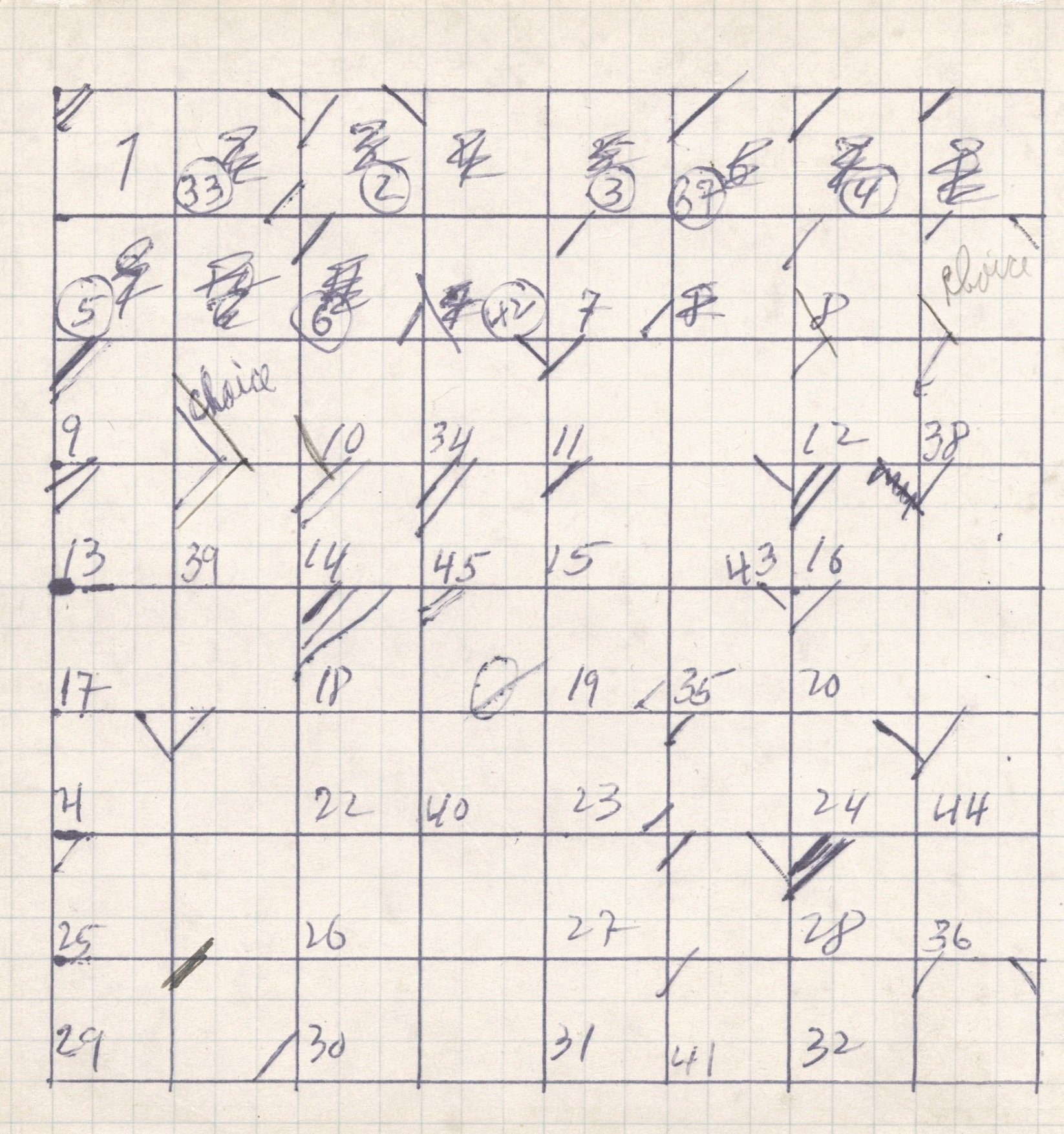(1) Rudolf Laban dance notation system, (2) The first six books of the Elements of Euclid’ by Oliver Byrne, (3) Bruno Munari Drawings of faces (4) kubikino sketches
Kubikino is the result of my background and passion for choreography, patterns, animation and the use of rules and chance as a compositional device.
On choreography
As a student at Dartington College of Arts my interest and practice gravitated around the definition of the term ‘choreography’ referring both to the art of writing dance (composition) as well as the act of documenting movement (dance notation). I was particularly interested in the work of Rudolf Laban and his attempt to translate movement into graphical elements. His scores are beautiful patterns conveying a sense of dynamic and composition. Yet I had reservations on the methodology. Is it possible to notate dynamic movement into a static piece of paper? This was the question that sparked my interest in motion graphics.
On animation
I started learning to make motion graphics with a choreographic approach, taking into account rules on space, dynamics, time and relationship. Similarly to dance, animation is about transitions and directions. One of the challenges in creating Kubikino was to find a rationale to create and resolve a face. We started from the + sign as an indicator of the beginning of a new composition. Each face is made of a number of tiles, each performing its own phrase in relation to the other tiles.
On patterns
Pattern design is about the space in between, the connections between tiles. What makes a modular pattern work is what happens on the edge of the tile. This is the point of connection or disconnection between tiles, this is the space in between that creates the larger picture. In designing Kubikino I was particularly inspired by the aesthetic and concept in ‘The first six books of the Elements of Euclid’ by Oliver Byrne. In the book, colours and graphics are used to support the understanding of strict rules of geometry. Kubikino starts from the shape of a circle and a grid. A set of very basic rules generates a large number of variations resulting in a very large number of possible faces.
On programming
A face is by definition as similar as it is distinct. Each Kubikino face is an unidentical identity. Using an essential library of elements - all deriving from the circle - and primary colours, the code randomly creates new faces resembling human physiognomy, animals or traditional masks.
Carolina Melis, 2023
From Choreography to Generative Art: Exploring the Evolution of Creativity and Composition
As an art student with a passion for dance, I delved into the topic of choreography, beginning with an exploration of the word itself. I was fascinated by the dual nature of the term, which refers both to the act of creating (composition) and the act of recording dance (scoring). In my view, the advent of the term "choreography," which Feuillet first introduced in 1700 through his publication Chorégraphie, ou l'art d'écrire la danse (Choreography or the Art of Recording Dance in Writing), inaugurated an entirely new discipline.
My research later led me to the topic of structured improvisation, which involves the combination of improvisation with pre-existing frameworks or structures. This creative process involves establishing a set of guidelines or rules that provide a foundation for improvisational exploration. These guidelines might take the form of specific themes, tempos, or musical keys, for example. While these constraints serve as a starting point for improvisation, performers are free to develop their own ideas within these boundaries.
It was not until I began working on a generative arts project called Kubikino, that I realized how my earlier interests in choreography and structured improvisation had anticipated my current passion for generative arts. Collaborating with creative coder Enrico Penzo on Kubikino, I found myself reflecting on the notations of Merce Cunningham and John Cage and their ideas about chance and structure.
I am intrigued by the similarities between the scores of the 1960s and some of the contemporary generative art pieces, including Kubikino. While the tools, languages, and mediums we use to create may evolve, the fundamental elements of creativity and composition remain constant. While artificial intelligence can aid in the creation of art, it cannot replicate the subjective human experience of appreciating and connecting with a piece of art. Although AI is increasingly sophisticated in its ability to generate creative works, it still lacks the nuanced understanding of the human experience that is essential for truly appreciating and engaging with a work of art.
Carolina Melis
A page from Choregraphie; ou, l'art de décrire la danse (1700), by Raoul Feuillet, illustrates the dance notation system originated by Pierre Beauchamp.
Merce Cunningham Movement Chart II C-D-E Extensions. Drawing for the dance Suite by Chance1952. MoMA
Identity and belonging
From prehistoric times to the present day, human identity has remained a subject of cultural fascination. The word "identity" derives from the Latin word "identitas," which means both "sameness" and "oneness." This dual meaning is intriguing, especially when examining historical and modern phenomena.
One modern phenomenon that illustrates the enduring fascination with identity is the popularity of avatar characters. Several factors contribute to their appeal, including the desire for a sense of belonging. Similar to traditional masks used to indicate belonging to a tribe, owning an PFP character grants entry into an exclusive community. The act of belonging is just as significant as the state of belonging.
In a digital world of easily accessible replicas, the search for PFP identities is likely to become even more sophisticated. The excitement of minting, the non-fungibility of tokens, and limited editions all contribute to the priceless nature of PFP characters. As this trend continues to grow, it will be interesting to see how it continues to shape our understanding of identity and belonging.
Carolina Melis




